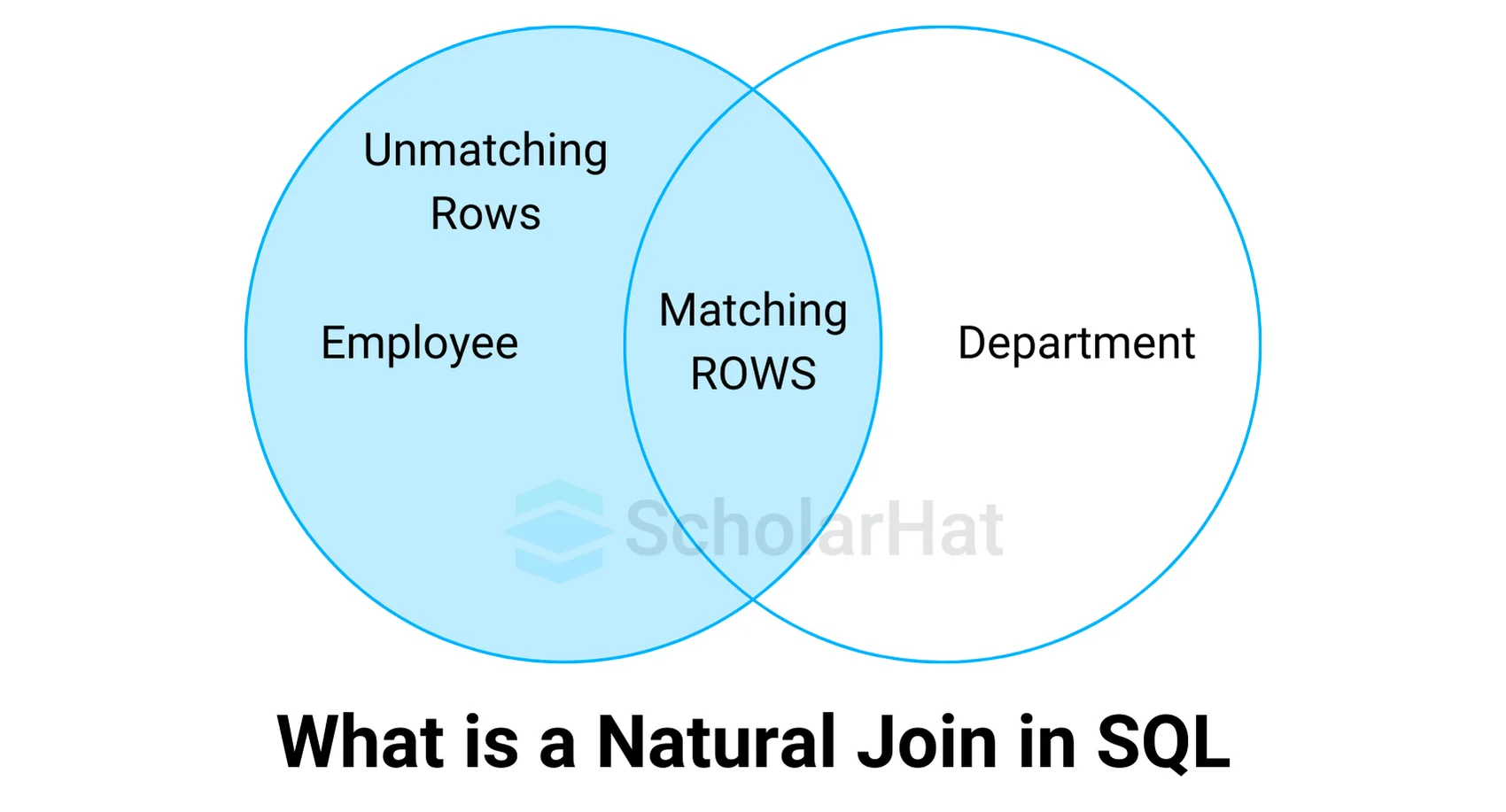Natural Joins in SQL are important for developers who want to merge data from multiple tables based on
columns with the same name and
data type. Imagine being able to combine related records automatically without specifying each column, resulting in a simplified and streamlined
query.
Natural Joins allow you to quickly retrieve relevant information by matching shared
columns, making them a powerful tool for efficient
database development.
In this
SQL tutorial, I’ll explain the fundamentals of
Natural Joins, how they simplify data retrieval by automatically matching columns, and why mastering them is crucial for building effective database applications.
85% of data analyst roles require SQL Server proficiency. Start your journey with our SQL Server Courses Online Free now! What is a Natural Join in SQL?- A Natural Join in SQL merges tables automatically based on columns that share the same name and data type.
- It matches and returns rows with equal values in these common columns, streamlining your query without needing to specify the columns explicitly.
- This approach provides a quick way to combine related data efficiently.
For example, if you have an Orders table with CustomerID, OrderDate, and a Customers table with CustomerID, CustomerName, a Natural Join will match and merge these tables based on CustomerID, showing orders along with customer names automatically.
Steps to Implement SQL Natural Join
Here, we will discuss the steps to implement SQL Natural Join using an example of a university database:
Step 1: Creating the Database
- First, you need to create a database. Let's name it.
university.
CREATE DATABASE university;
Step 2: Using the Database
- Now, use the newly created database by running the following command:
USE university;
Step 3: Creating Reference Tables in the Database
- Next, you will create two tables:
Courses and Students in your database. - Here is how you can define these tables:
Table-1: Courses
CREATE TABLE Courses (
CourseID VARCHAR(10),
CourseName VARCHAR(50),
Instructor VARCHAR(50)
);
Table-2: Students
CREATE TABLE Students (
StudentID INT,
StudentName VARCHAR(50),
CourseID VARCHAR(10)
);
Step 4: Inserting Values into the Tables
- Now, it is time to insert some data into these tables.
- You will populate the
Courses and Students tables with relevant information.
Inserting Data into the Courses Table
INSERT INTO Courses (CourseID, CourseName, Instructor) VALUES ("CS101", "Computer Science", "Dr. Aditi");
INSERT INTO Courses (CourseID, CourseName, Instructor) VALUES ("ENG102", "English Literature", "Prof. Vikram");
INSERT INTO Courses (CourseID, CourseName, Instructor) VALUES ("MATH103", "Calculus", "Dr. Meena");
INSERT INTO Courses (CourseID, CourseName, Instructor) VALUES ("PHY104", "Physics", "Dr. Prakash");
INSERT INTO Courses (CourseID, CourseName, Instructor) VALUES ("CHE105", "Chemistry", "Dr. Pooja");
Inserting Data into the Student's Table
INSERT INTO Students (StudentID, StudentName, CourseID) VALUES (1, "Amit", "CS101");
INSERT INTO Students (StudentID, StudentName, CourseID) VALUES (2, "Priya", "ENG102");
INSERT INTO Students (StudentID, StudentName, CourseID) VALUES (3, "Rajesh", "MATH103");
INSERT INTO Students (StudentID, StudentName, CourseID) VALUES (4, "Sneha", "PHY104");
INSERT INTO Students (StudentID, StudentName, CourseID) VALUES (5, "Rohan", "CS101");
Step 5: Verifying the Inserted Data
- It's a good idea to verify the data you've inserted into the tables.
- You can do this with the following queries:
Query to Check Student's Table
SELECT * FROM Students;
Output
| StudentID | StudentName | CourseID |
|---|
| 1 | Amit | CS101 |
| 2 | Priya | ENG102 |
| 3 | Rajesh | MATH103 |
| 4 | Sneha | PHY104 |
| 5 | Rohan | CS101 |
Query to Check Courses Table
SELECT * FROM Courses;
Output
| CourseID | CourseName | Instructor |
|---|
| CS101 | Computer Science | Dr. Aditi |
| ENG102 | English Literature | Prof. Vikram |
| MATH103 | Calculus | Dr. Meena |
| PHY104 | Physics | Dr. Prakash |
| CHE105 | Chemistry | Dr. Pooja |
Step 6: Implementing the SQL Natural Join
- Finally, you will perform a Natural Join to combine the
Students and Courses tables based on the common CourseID column.
SELECT *
FROM Students
NATURAL JOIN Courses;
Output of the Natural Join
| StudentID | StudentName | CourseID | CourseName | Instructor |
|---|
| 1 | Amit | CS101 | Computer Science | Dr. Aditi |
| 2 | Priya | ENG102 | English Literature | Prof. Vikram |
| 3 | Rajesh | MATH103 | Calculus | Dr. Meena |
| 4 | Sneha | PHY104 | Physics | Dr. Prakash |
| 5 | Rohan | CS101 | Computer Science | Dr. Aditi |
Pictorial Presentation of the Above SQL Natural Join

Natural Join: Guidelines
The guidelines of natural join are as follows
- Ensure that the tables have columns with the same name and datatype before using a Natural Join.
- Use Natural Joins when you are certain of the column names and consistency to avoid incorrect results.
- Avoid using Natural Joins with tables that lack proper naming conventions, as this can lead to unintended matches.
Advantages and Disadvantages
- Advantages:
- Automatically matches columns with the same name, simplifying query writing.
- Reduces the need for explicitly specifying join conditions, leading to cleaner queries.
- Disadvantages:
- Risk of unintended matches if columns have the same name but represent different data.
- Less control over the join condition compared to other types like Inner Join or Equi Join.
Practical Examples of Natural Join
Let’s imagine you are managing a database for a university. In this database, there are two tables: Students and Enrollments. You want to retrieve information about students and the courses they are enrolled in.
Students Table
| StudentID | Name |
|---|
| 1 | Amit |
| 2 | Priya |
| 3 | Rajesh |
| 4 | Sneha |
Enrollments Table
| StudentID | CourseID | Grade |
|---|
| 1 | CS101 | A |
| 2 | ENG102 | B |
| 3 | MATH103 | A |
| 1 | PHY104 | B |
| 4 | CS101 | A |
Using Natural Join
- Now, let’s say you want to find out the names of students along with their course grades.
- You can achieve this using a Natural Join, which will automatically match the StudentID column in both tables.
SQL Query
SELECT Students.Name, Enrollments.CourseID, Enrollments.Grade
FROM Students
NATURAL JOIN Enrollments;
Output
- When you run the above query, the result will be as follows:
| Name | CourseID | Grade |
|---|
| Amit | CS101 | A |
| Amit | PHY104 | B |
| Priya | ENG102 | B |
| Rajesh | MATH103 | A |
| Sneha | CS101 | A |
Explanation
- In this example, the Natural Join simplifies the process of retrieving relevant data.
- Instead of explicitly defining the join condition, you let SQL automatically match the StudentID in both tables.
- This not only reduces the complexity of your query but also makes it easier to read and maintain.
Key Takeaways
- Efficiency: Natural Joins reduce the need to specify join conditions, making the SQL queries cleaner.
- Automatic Matching: It automatically matches columns with the same name and data type, which can save time when writing complex queries.
- Practical Use Cases: This type of join is particularly useful in scenarios where you have well-structured databases with clearly defined relationships, like educational systems, inventory management, and more.
By using Natural Joins, you can focus more on what data you need rather than how to combine it, leading to faster and more effective database management.
Common Pitfalls and Solutions
1. Common Pitfall: Misleading Results due to Unexpected Column Matches
- Solution: Always verify that the column names you intend to match are identical in both name and data type across tables.
2. Common Pitfall: Unintended Cartesian Product When No Matching Columns Are Found
- Solution: Avoid using Natural Joins on tables without shared column names to prevent data explosion.
Natural Join vs. Inner Join














